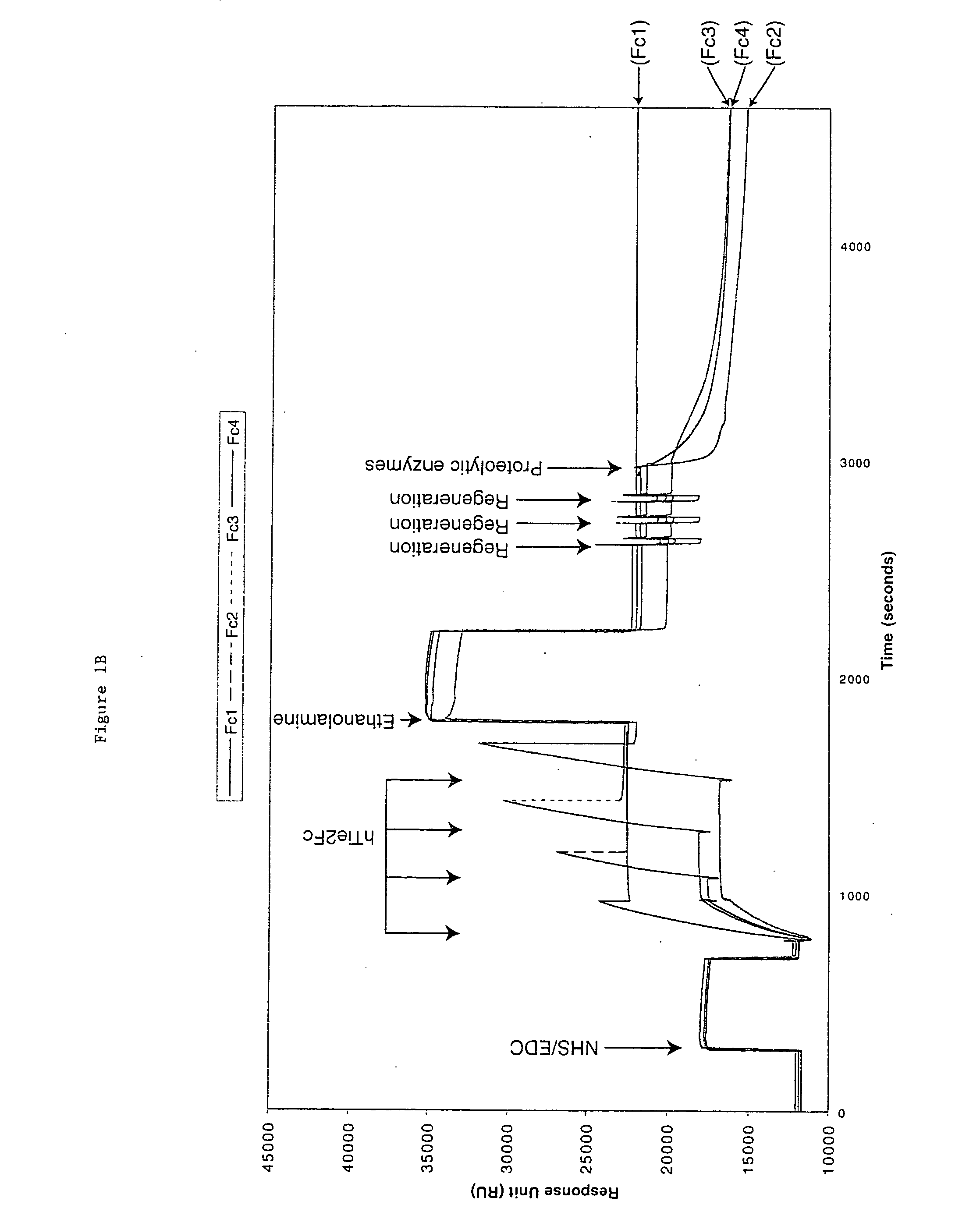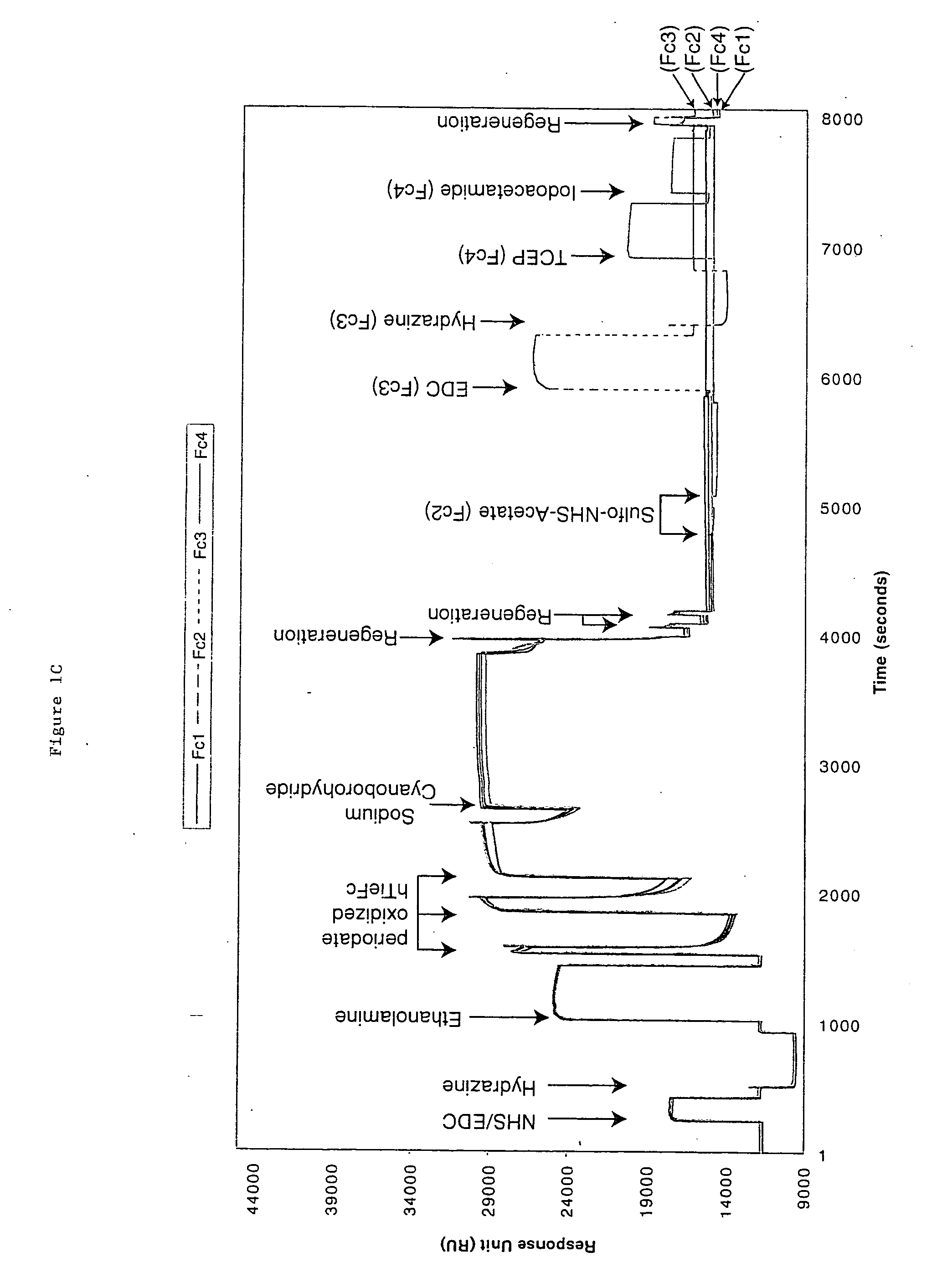Modification assisted profiling (MAP) methodology
a mapping and modification technology, applied in the field of analytical biochemistry, can solve the problems of difficult to find chemical modification conditions that are residue-specific, difficult to integrate the necessary assays into the primary hybridoma screening process, and difficult to find chemical procedures that not only efficiently
- Summary
- Abstract
- Description
- Claims
- Application Information
AI Technical Summary
Benefits of technology
Problems solved by technology
Method used
Image
Examples
example 1
General Methods and Materials
[0050] Biosensor instruments, biosensor surfaces, and related reagents--The Biacore 3000, 2000, and 1000 instruments are manufactured by Biacore AB Rapsgatan 7 S-754 50 Uppsala, Sweden). Sensor surface chips CM5 or F1 were used for immobilization and modification of the antigen. The 50 mM N-hydroxysuccinimide (NHS) in H.sub.2O; 200 mM N-ethyl-N'-(dimethylaminopropyl) carbodiimide (EDC) in H.sub.2O; and 1M ethanolamine hydrochloride pH 8.5 were prepared using an Amine Coupling Kit purchased from Biacore AB. HBS-EP Buffer: 10 mM Hepes pH 7.4, 150 mM NaCl, 3 mM EDTA, 0.005% surfactant P20. The reagents for Aldehyde coupling were 0.1M sodium cyanoborohydride in 0.1M acetate buffer, pH 4.0; 5 mM hydrazine in H.sub.2O; sodium metaperiodate 50 mM in 100 mM acetate buffer pH 5.5; and 120 mM sodium sulfite in 100 mM acetate buffer, pH 5.5. Carboxymethyl dextran was purchased from Fluka Chemicals (St. Gallen, Switzerland).
[0051] Proteolytic enzymes--Modified porci...
example 2
Preparation of Modified hTie2-Fc on Biosensor Surfaces
[0058] hTie2-Fc protein is a 212 kDa dimer containing two 106 kDa hTie2-Fc polypeptides covalently linked by two disulfide bonds provided by the Fc portion of the fusion protein. The protein also contains 10% carbohydrate. hTie2-Fc was coupled to a CM5 biosensor chip surface by a standard NHS / EDC-mediated amine coupling procedure. The amount of hTie2-Fc coupled to each flow-cell surface should be between 3000 to 10,000 RU. To minimize a crowding effect, the preferred coupling density should be around 5000 RU. It is important to couple nearly identical amounts of hTie2-Fc to all four flow-cells so fair comparisons can be made between binding to the three modified flow-cell signals and the non-modified control flow-cell surface.
[0059] Six sequencing-grade proteolytic enzymes were used to modify each coupled hTie2-Fc surface: Trypsin, endoproteinase Glu-C and endoproteinase Asp-N to modify flow cell 2, 3, and 4 from the first biosen...
example 3
Generating Monoclonal Antibody Binding Profiles Using the Biacore 2000
[0065] Hybridoma conditioned media samples were diluted at 1:1 ratio with 2.times. dilution buffer (20 mM Hepes, pH 7.4, 300 mM NaCl, 6 mM EDTA, 0.01% Surfactant P20 and 40 mg / ml CMDX) in 96-well microtiter plates. The binding of each monoclonal hybridoma sample to each biosensor chip that contained one unmodified hTie2-Fc surface and three separately modified hTie2-Fc surfaces was performed automatically under the control of Biacore software.
[0066] When all of the mAb binding data to the three separate chips which contain the nine modified hTie2-Fc surfaces and three unmodified hTie2-Fc control surfaces were collected, all of the nine response RU values of each antibody to the nine modified hTie2-Fc surfaces were converted into response ratios to that of the unmodified controls.
[0067] The response data of all the tested anti-hTie2 mAbs (110 mAbs and 174 primary hybridoma conditioned media supernatants and 6 hTie2...
PUM
| Property | Measurement | Unit |
|---|---|---|
| pH | aaaaa | aaaaa |
| pH | aaaaa | aaaaa |
| flow rate | aaaaa | aaaaa |
Abstract
Description
Claims
Application Information
 Login to View More
Login to View More - R&D
- Intellectual Property
- Life Sciences
- Materials
- Tech Scout
- Unparalleled Data Quality
- Higher Quality Content
- 60% Fewer Hallucinations
Browse by: Latest US Patents, China's latest patents, Technical Efficacy Thesaurus, Application Domain, Technology Topic, Popular Technical Reports.
© 2025 PatSnap. All rights reserved.Legal|Privacy policy|Modern Slavery Act Transparency Statement|Sitemap|About US| Contact US: help@patsnap.com



